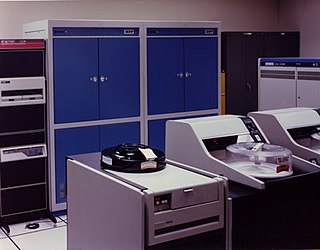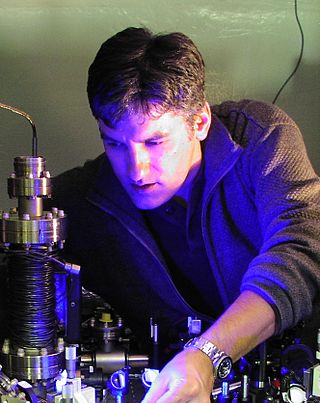Related Research Articles

An integrated circuit, also known as a microchip or IC, is a small electronic device made up of multiple interconnected electronic components such as transistors, resistors, and capacitors. These components are etched onto a small piece of semiconductor material, usually silicon. Integrated circuits are used in a wide range of electronic devices, including computers, smartphones, and televisions, to perform various functions such as processing and storing information. They have greatly impacted the field of electronics by enabling device miniaturization and enhanced functionality.

A microprocessor is a computer processor for which the data processing logic and control is included on a single integrated circuit (IC), or a small number of ICs. The microprocessor contains the arithmetic, logic, and control circuitry required to perform the functions of a computer's central processing unit (CPU). The IC is capable of interpreting and executing program instructions and performing arithmetic operations. The microprocessor is a multipurpose, clock-driven, register-based, digital integrated circuit that accepts binary data as input, processes it according to instructions stored in its memory, and provides results as output. Microprocessors contain both combinational logic and sequential digital logic, and operate on numbers and symbols represented in the binary number system.

The PDP–11 is a series of 16-bit minicomputers sold by Digital Equipment Corporation (DEC) from 1970 into the late 1990s, one of a set of products in the Programmed Data Processor (PDP) series. In total, around 600,000 PDP-11s of all models were sold, making it one of DEC's most successful product lines. The PDP-11 is considered by some experts to be the most popular minicomputer.

VAX is a series of computers featuring a 32-bit instruction set architecture (ISA) and virtual memory that was developed and sold by Digital Equipment Corporation (DEC) in the late 20th century. The VAX-11/780, introduced October 25, 1977, was the first of a range of popular and influential computers implementing the VAX ISA. The VAX family was a huge success for DEC, with the last members arriving in the early 1990s. The VAX was succeeded by the DEC Alpha, which included several features from VAX machines to make porting from the VAX easier.

A Connection Machine (CM) is a member of a series of massively parallel supercomputers that grew out of doctoral research on alternatives to the traditional von Neumann architecture of computers by Danny Hillis at Massachusetts Institute of Technology (MIT) in the early 1980s. Starting with CM-1, the machines were intended originally for applications in artificial intelligence (AI) and symbolic processing, but later versions found greater success in the field of computational science.

Meiko Scientific Ltd. was a British supercomputer company based in Bristol, founded by members of the design team working on the Inmos transputer microprocessor.

Parallel computing is a type of computation in which many calculations or processes are carried out simultaneously. Large problems can often be divided into smaller ones, which can then be solved at the same time. There are several different forms of parallel computing: bit-level, instruction-level, data, and task parallelism. Parallelism has long been employed in high-performance computing, but has gained broader interest due to the physical constraints preventing frequency scaling. As power consumption by computers has become a concern in recent years, parallel computing has become the dominant paradigm in computer architecture, mainly in the form of multi-core processors.

The history of computing hardware starting at 1960 is marked by the conversion from vacuum tube to solid-state devices such as transistors and then integrated circuit (IC) chips. Around 1953 to 1959, discrete transistors started being considered sufficiently reliable and economical that they made further vacuum tube computers uncompetitive. Metal–oxide–semiconductor (MOS) large-scale integration (LSI) technology subsequently led to the development of semiconductor memory in the mid-to-late 1960s and then the microprocessor in the early 1970s. This led to primary computer memory moving away from magnetic-core memory devices to solid-state static and dynamic semiconductor memory, which greatly reduced the cost, size, and power consumption of computers. These advances led to the miniaturized personal computer (PC) in the 1970s, starting with home computers and desktop computers, followed by laptops and then mobile computers over the next several decades.
Bio-inspired computing, short for biologically inspired computing, is a field of study which seeks to solve computer science problems using models of biology. It relates to connectionism, social behavior, and emergence. Within computer science, bio-inspired computing relates to artificial intelligence and machine learning. Bio-inspired computing is a major subset of natural computation.

The history of computing hardware in the Eastern Bloc is somewhat different from that of the Western world. As a result of the CoCom embargo, computers could not be imported on a large scale from Western Bloc.

The Goodyear Massively Parallel Processor (MPP) was a massively parallel processing supercomputer built by Goodyear Aerospace for the NASA Goddard Space Flight Center. It was designed to deliver enormous computational power at lower cost than other existing supercomputer architectures, by using thousands of simple processing elements, rather than one or a few highly complex CPUs. Development of the MPP began circa 1979; it was delivered in May 1983, and was in general use from 1985 until 1991.

The R3000 is a 32-bit RISC microprocessor chipset developed by MIPS Computer Systems that implemented the MIPS I instruction set architecture (ISA). Introduced in June 1988, it was the second MIPS implementation, succeeding the R2000 as the flagship MIPS microprocessor. It operated at 20, 25 and 33.33 MHz.
The transistor count is the number of transistors in an electronic device. It is the most common measure of integrated circuit complexity. The rate at which MOS transistor counts have increased generally follows Moore's law, which observes that transistor count doubles approximately every two years. However, being directly proportional to the area of a chip, transistor count does not represent how advanced the corresponding manufacturing technology is: a better indication of this is transistor density.
This article covers the History of CP/CMS — the historical context in which the IBM time-sharing virtual machine operating system was built.

Anant Agarwal is an Indian computer architecture researcher. He is a professor of Electrical Engineering and Computer Science at the Massachusetts Institute of Technology (MIT), where he led the development of Alewife, an early cache coherent multiprocessor, and also has served as director of the MIT Computer Science and Artificial Intelligence Laboratory. He is the founder and CTO of Tilera, a fabless semiconductor company focusing on scalable multicore embedded processor design. He also serves as the CEO of edX, a joint partnership between MIT and Harvard University that offers free online learning.
Alewife was a cache coherent multiprocessor developed in the early 1990s by a group led by Anant Agarwal at the Massachusetts Institute of Technology. It was based on a network of up to 512 processing nodes, each of which used the Sparcle computer architecture, which was formed by modifying a Sun Microsystems SPARC CPU to include the APRIL techniques for fast context switches.
The VAX 9000 is a discontinued family of mainframes developed and manufactured by Digital Equipment Corporation (DEC) using custom ECL-based processors implementing the VAX instruction set architecture (ISA). Equipped with optional vector processors, they were marketed into the supercomputer space as well. As with other VAX systems, they were sold with either the VMS or Ultrix operating systems.
This article details the history of electronics engineering. Chambers Twentieth Century Dictionary (1972) defines electronics as "The science and technology of the conduction of electricity in a vacuum, a gas, or a semiconductor, and devices based thereon".

Christopher Roy Monroe is an American physicist and engineer in the areas of atomic, molecular, and optical physics and quantum information science, especially quantum computing. He directs one of the leading research and development efforts in ion trap quantum computing. Monroe is the Gilhuly Family Presidential Distinguished Professor of Electrical and Computer Engineering and Physics at Duke University and is College Park Professor of Physics at the University of Maryland and Fellow of the Joint Quantum Institute and Joint Center for Quantum Computer Science. He is also co-founder of IonQ, Inc.
References
- ↑ Agarwal, Anant; et al. (June 1993). "Sparcle: An Evolutionary Processor Design for Large-scale Multiprocessors" (PDF). IEEE Micro. 13 (3): 48–61. doi:10.1109/40.216748. S2CID 14678370 . Retrieved Feb 5, 2020.